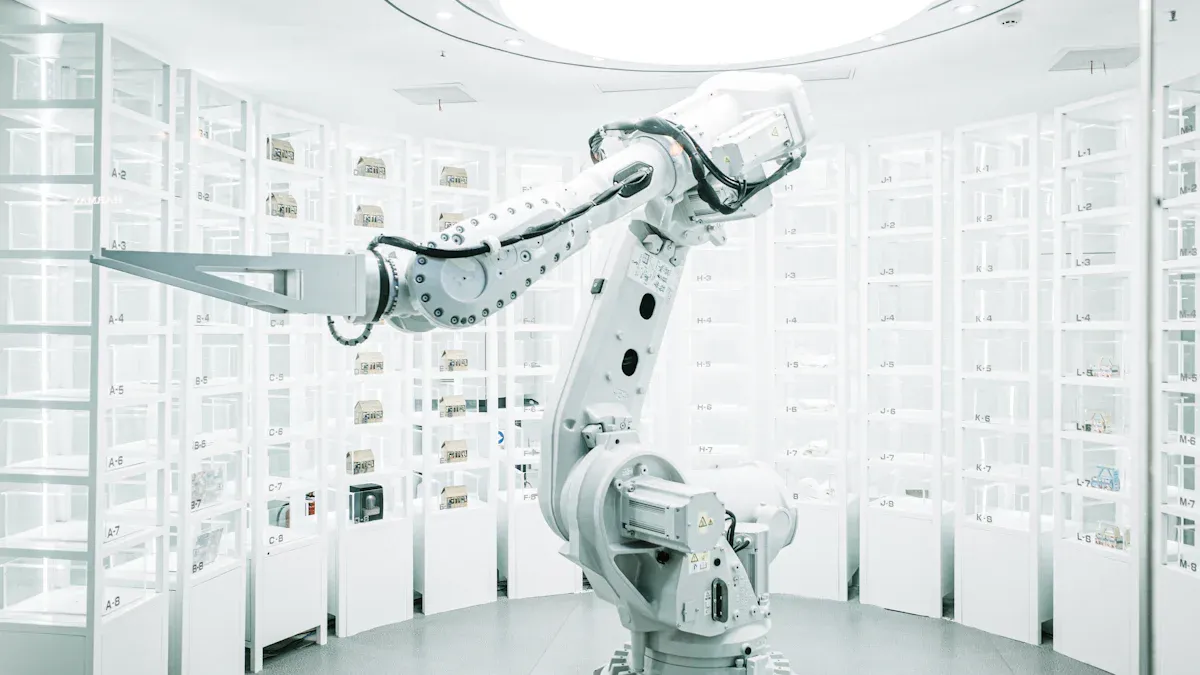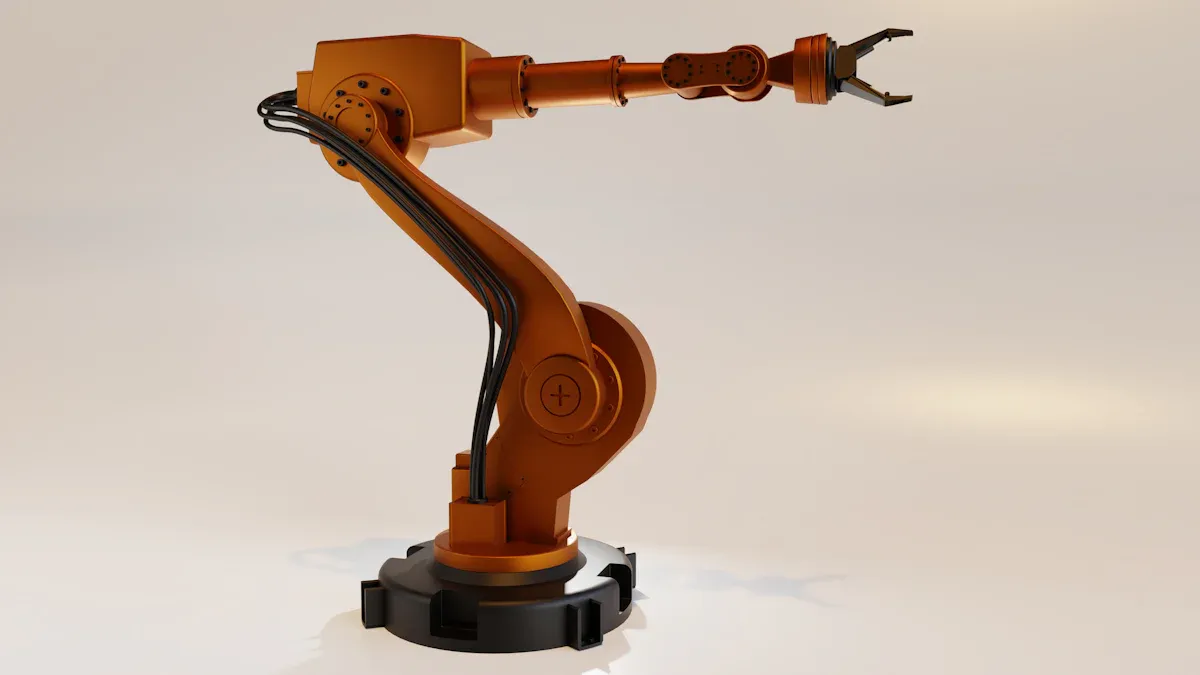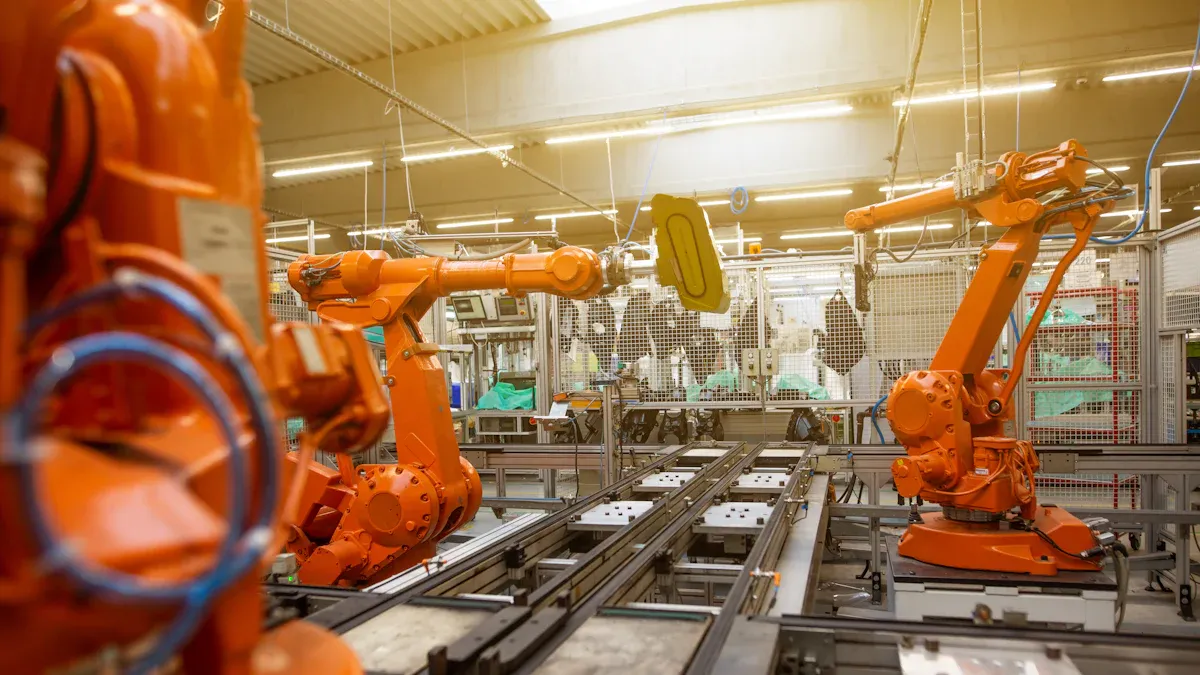- All
- Product Name
- Product Keyword
- Product Model
- Product Summary
- Product Description
- Multi Field Search












A robot arm is a device you can program. It moves and works like a human arm. You can use a robot arm for hard or repeated jobs. It also does careful tasks fast and well. In robotics, a robot arm uses motors and joints. It also uses manipulators to do work in factories and schools. Robot arms help you do work automatically. They help you build things and learn about technology. The world market for robot arms is growing fast:
| Source | Projected CAGR | Market Value by 2029 |
|---|---|---|
| Market Report Analytics | 8% | $22 billion |
| The Business Research Company | 15.5% | $42.63 billion |
| Data Bridge Market Research | 15.6% | $76.2 billion |
Robot arms help do jobs faster and safer. People use them in factories, schools, and homes. They do things like putting parts together and welding.
Picking the right robot arm depends on what you need. Think about what jobs it will do and how much space you have.
Collaborative robot arms, called cobots, work safely with people. You can easily program them for many jobs. This makes them great for places that need flexible work.
A robotic arm is made of many parts. Each part does a special job. All the parts work together. This helps the robot move and grab things. It also helps the robot sense what is around it. Here is a table that lists the main parts and what they do:
| Component | Function |
|---|---|
| Base and mounting system | Holds the arm steady on a surface. It keeps the arm stable and helps it work well. |
| Joints and links | Connect the arm pieces. They let the arm bend and reach. |
| Actuators | Make the joints move. They turn signals into motion. |
| End effector (gripper) | Works like the robot’s hand. It grabs or moves things for different jobs. |
| Sensors | Give data about position and force. They help the robot move safely and correctly. |
Robotic arms use different actuators. Some use rotary electric motors to turn joints. These motors are called servo or stepper motors. Other arms use linear actuators for straight moves. Some robots use pneumatic or hydraulic drives. These make the arm move fast and strong.
The end effector is the tool at the tip of the arm. You can pick from many types:
Mechanical grippers hold objects tight.
Vacuum suction grippers stick to smooth things.
Magnetic grippers lift metal pieces.
Soft grippers pick up fragile or odd-shaped items.
Sensors are very important in robotics. They measure position, speed, and torque. This feedback helps the arm adjust itself quickly. The robot can move safely and exactly, even when tasks are hard.
Tip: Picking the right end effector helps your robot arm do many jobs. It can pick and place, build things, or handle gentle items.
A robotic arm moves like your own arm. Each joint can move by itself. This gives the arm more ways to move. The number of joints is called degrees of freedom. More degrees of freedom means the arm can reach more places. It can also do harder jobs. Fewer degrees of freedom make the arm simple but less able to move.
You control a robotic arm by programming it. You use software to tell the robot what to do. Programmability lets you change the robot’s job fast. For example, you can switch from building things to sorting items with a new program.
Actuators are like the robot’s muscles. They change energy into movement. When actuators work with sensors, the arm moves very accurately. Sensors send information to the controller. The robot knows where it is and can change its moves quickly.
Modern robotic arms use machine vision and artificial intelligence. These tools help the robot see and understand its world. The robot learns from data and gets better at its jobs. This makes robots useful for many tasks, like factory work or helping people.
There are real examples of advanced robotic arms. The Kinova Jaco arm helps people who have trouble moving. It attaches to wheelchairs and has a modular design. Many people in the United States and other countries use this technology every day.
There are many kinds of robotic arms. Some are built for heavy lifting in factories. Others are small and safe to use near people. When you pick a robotic arm, think about what you need it to do. The best robotic arm will fit your needs, whether you want to automate work or teach students.
Robotic arms help with jobs that are hard, risky, or boring. They can pick and place things, build products, or check parts. With the right setup, a robot arm can work faster and more accurately than a person.

You can see many kinds of robot arms in different places. They are used in factories, labs, and schools. Each type has its own shape and job. The table below shows how they are different:
| Type | Structure Description | Common Applications |
|---|---|---|
| Cartesian | Moves in straight lines along X, Y, and Z axes | Pick and place, assembly operations, welding |
| Cylindrical | Rotates at the base and moves up and down | Assembly operations, machine tool handling |
| Spherical/Polar | Rotates and extends in a ball-shaped area | Welding, coating, machine tool handling |
| Articulated | Has several rotary joints, like a human arm | Welding, painting, material handling |
| SCARA | Two parallel rotary joints for flat movement | Assembly tasks, packaging |
| Parallel/Delta | Uses several arms for fast, precise moves | Pick and place, packaging |
| Anthropomorphic | Looks and moves like a human arm | Works with people, research |
| Six-axis | Offers six degrees of freedom for complex tasks | Industrial robot jobs, automation |
| Collaborative | Built to work safely with humans | Shared workspaces, flexible tasks |
Articulated robotic arms are used the most in factories. They have five or more joints. You often see them doing welding, painting, or moving things. SCARA and Cartesian robotic arms are also common. They are good for putting things together and moving items.
Collaborative robotic arms, called cobots, work close to people. They have safety features to keep you safe. Cobots help with boring or dangerous jobs. You can change what they do by programming them. This makes cobots useful in many places.
Note: Cobots must follow strict safety rules, like ISO/TS 15066. They use sensors to control speed and force. This helps protect people.
Educational robotic arms help students learn about robotics. You can build, program, and test these robots in class. Projects like VEX GO STEM Labs let you solve real problems. You learn teamwork, coding, and design skills. These skills help you get ready for jobs in robotics.
Robotic arms are important in factories and schools. You can use them to learn about robotics, work faster, and stay safe.

You can find robotic arms in many industries. These machines help people work faster and safer. They do jobs that need strength, speed, or careful moves. Here are some main industries where you see robot arms:
| Industry | Main Tasks Performed |
|---|---|
| Automotive | Welding, material removal, CNC loading, palletizing |
| Aerospace | Heavy payload assembly |
| Electronics | PCB assembly, soldering, testing, cleanroom handling |
| Agriculture | Various tasks in farming and crop management |
| Construction | Tasks related to building and infrastructure development |
| Consumer Goods | Packing, inspection, and assembly |
| Energy Technology and Utilities | Maintenance and operational tasks |
Robotic arms help with assembly in factories. You use them for welding, painting, and lifting heavy parts. In electronics, robots put small pieces on circuit boards. In agriculture, robots help plant and pick crops. Construction sites use robot arms to build and move things. Robots also work in warehouses to pick and pack items.
Here are some examples of how you use robotic arms:
Robot arms move things in warehouses.
You use remote-control grasping to pick up hard-to-reach items.
You program robots to sort packages or put products together.
Some robots have flying drones with robot arms. ETH Zurich made a small drone with a folding arm to carry light loads. Ritsumeikan University built a drone with a gripper to change bulbs or pick fruit. These new ideas show how robots solve real problems.
Robotic arms make work easier and safer. They do boring or risky jobs for you. You can focus on tasks that need thinking and creativity. Robots work all day and do not get tired, so you finish more work.
Tip: There are about 4 million industrial robots in factories now. By 2030, most people will use smart robots every day.
When you pick a robot arm, you need to think about some important things. Each job needs a different kind of robot arm. Here are the main things to look at:
| Factor | Description |
|---|---|
| Degrees of Freedom | A 7DoF robot arm moves like a human arm and reaches tight spaces. |
| Strength | Check the maximum payload. Heavy loads may lower accuracy. |
| Reach | Measure how far the arm can stretch from its base. |
| Speed | Fast robots help with quick jobs. |
| Accuracy | High repeatability is needed for small parts. |
| Gripper Availability | More grippers mean more ways to use the robot. |
| ROS Compatibility | Makes it easy to connect with other robotics systems. |
| Collaborative Use | Lets robots work safely with people. |
| IP Classification | Shows how well the robot resists dust and water. |
| CE Marking | Meets EU safety rules. |
| Budget | Think about the total cost for your robot arm. |
You should check reach and payload. Reach tells you how high and far the arm can go. Payload means how much weight the robot can lift. Makers test these limits to make sure the robot works well. Repeatability is also important. This means the robot arm can go back to the same spot every time. Many robot arms can repeat moves as close as 0.02 millimeters.
Here are some other things to think about:
Flexibility: Decide how many degrees of freedom you need.
Space: Make sure you have enough room for the robot arm.
Engineering: Plan for design and setup costs.
Reliability: Pick a robot that is easy to fix and does not break often.
Cost matters a lot. Basic robot arms cost $4,000 to $6,000. Welding and automation arms with six axes cost $8,500 to $12,820. Collaborative robot arms, called cobots, cost $5,000 to $10,000. Maintenance costs start low but go up as the robot gets older.
You need good support and care for your robot arm. Cleaning and testing keep the robot working well. You should check sensors, cables, and hoses. Oil the joints and change filters when needed. Full safety checks help stop accidents.
Robotic arms help you work faster and make fewer mistakes. They improve product quality and let you focus on harder jobs. Robots also help the environment by saving energy and cutting waste. They sort things for recycling and watch nature with drones.
You may face some problems when you add robots to your workspace. Robots need more space than people. You might need special tools for different jobs. Some places do not have enough power or air for robots. Careful planning helps you avoid trouble.
Safety rules are very important in robotics. Standards like ANSI/A3 R15.06-2025 make sure robots work safely with people. You must follow these rules to keep everyone safe.
Note: When you pick a robot arm, think about what you want it to do, how much it costs, and how easy it is to keep working. The right choice helps you get the most from robotics.
You have learned that a robot arm can help with many jobs. Robotic arms are used in factories, schools, and homes. Before picking a robot, remember these important things:
| Key Consideration | Description |
|---|---|
| Understanding Specific Needs | Decide what items the robot will handle, how accurate it must be, and how much it will make. |
| Workspace Dimensions | Check if your space is big enough for the robot arm to fit and work well. |
| Configuration Requirements | Think about how much you need to change the robot arm for your job. |
| Durability and Maintenance | Look at how long the robot arm will last and how often it needs fixing. |
| Cost Considerations | Think about the price, how much it costs to run, and if you need to pay for training. |
| Vendor Support | Make sure you can get help, a good warranty, and spare parts after you buy it. |
Knowing about the types and uses of robotic arms helps you choose wisely. If you want to learn more or build a robot, check out these resources:
| Resource Title | Description |
|---|---|
| Introduction to Robotic Systems Education Kit | Find teaching tools on GitHub to help you learn about mechatronics and robotic systems. |
| Robotic Arm Challenge | Try a lesson plan where you make special end effectors for robot arms. |
| Automated Robotic Arm That Learns | Follow a guide to build a robot arm that learns tasks with Tinkercad and Arduino. |
Tip: Begin with an easy robot project to grow your robotics skills.
You use robot arms to automate tasks. They help with assembly, welding, and picking items. You see them in factories, schools, and research labs.
Yes! Many robot arms use drag-and-drop software. You move blocks or icons to set actions. This makes programming easy for beginners.
Collaborative robot arms have sensors and safety features. They stop if you touch them. You can work near them without worry.